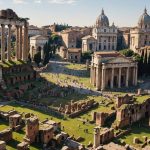Visiting the Colosseum is not just about seeing a landmark; it’s about experiencing history. With over 6 million visitors each year, planning your trip effectively can transform your experience. From securing tickets to finding the perfect time to visit, this guide offers practical tips to help you navigate this iconic structure. Discover how to enhance your journey and immerse yourself in the stories that echo through its ancient walls.
Practical Tips for Visiting the Colosseum
To make the most of your visit to the Colosseum, securing tickets in advance is crucial. During peak seasons, same-day ticket availability is notably low, making pre-booking almost essential. Access to different areas varies with ticket types. Basic entry allows ground-level exploration, while options like the Full Experience offer a fascinating look into the underground chambers and arena floors, details surely to discover on Visit Colosseum Rome.
In parallel : Top escape rooms in paris that expert players must try
For those curious about the best times to visit, early morning around 9 AM or within the hour before closing are less crowded. Weekdays provide a quieter experience compared to weekends, with the first Sunday of every month being exceptionally busy due to free admissions. For those seeking a more tranquil encounter, consider night tours, although these don’t include adjoining sites like the Roman Forum or Palatine Hill. Whether you opt for a brief self-guided stroll or a more detailed guided tour, planning effectively not only enhances your visit but also ensures a deeper appreciation of this iconic landmark. Prioritize comfort with appropriate attire to suit Rome’s diverse weather conditions.
Understanding the Colosseum’s History and Significance
The Colosseum, constructed between 70 and 80 AD, was a marvel of Roman engineering and hosted grand spectacles for over 50,000 spectators. It symbolized Roman power and provided an arena for gladiatorial games, animal hunts, and battle reenactments, deeply influencing ancient Roman culture.
Also read : Explore borghese gallery: top tips for an unforgettable visit
Overview of the Colosseum’s Construction and Purpose
The Colosseum, also known as the Flavian Amphitheatre, stands as a testament to the ingenuity of ancient Roman engineering. Constructed between 70 and 80 AD, its architectural marvel was commissioned by Emperor Vespasian. This colossal structure accommodated over 50,000 spectators, serving as a hub for gladiatorial games and various public spectacles. Its elliptical design was purpose-built for grand events, allowing for efficient crowd movement and unobstructed views of the arena.
Significance of the Colosseum in Ancient Roman Culture and Events
In its prime, the Colosseum was a focal point of Roman cultural life. It hosted gladiator battles, animal hunts, and reenactments of famous battles, reflecting the society’s appetite for entertainment mixed with brutality. The amphitheater served not only as a venue for these events but also as a symbol of the empire’s might and architectural prowess, uniting diverse segments of society in shared experiences.
Fascinating Facts and Figures About the Colosseum
Despite suffering from centuries of natural disasters and stone looters, the Colosseum’s grandeur remains unmatched. Over 6 million tourists flock to this historical gem annually, eager to explore its hallowed grounds. Notably, this cultural icon is an incredible feat of Ancient Rome’s mastery of construction techniques, standing as a beloved historical treasure in modern times.
Enhancing Your Colosseum Experience
Capture unforgettable photographs by arriving early and exploring angles from nearby parks. Plan your visit to include surrounding sites like the Roman Forum and Palatine Hill, which provide a fuller appreciation of ancient Roman life. Don’t forget to refuel at local eateries and prioritize safety while exploring.
Best Photography Spots and Tips for Capturing the Colosseum
Maximize your photography at the Colosseum by arriving early to capture the iconic structure without the crowd. Consider angles from Via Sacra for a classic shot. The nearby Colle Oppio Park offers a unique perspective for exploring ancient Rome complemented by verdant scenery. For budding photographers, adjust your camera during golden hour, either at sunrise or sunset, for stunning captures that highlight the timeless beauty of Rome’s landmark.
Nearby Attractions and Planning Your Visit
When exploring the ancient wonders, plan a seamless itinerary including famous landmarks like the Roman Forum and Palatine Hill, easily accessible with a combined Colosseum and Roman Forum combo ticket. Short walks lead to the Arch of Constantine and the breathtaking views from the Capitoline Hill, presenting an authentic taste of ancient Rome’s grandeur. To manage your day effectively, start with the Colosseum’s archaeological sites, then proceed to neighboring attractions to avoid afternoon crowds.
Dining Options and Safety Practices
Fuel your day at some choice spots offering delicious food options near the Colosseum. Try local Italian dining just a stone’s throw away at the Monti district. Prioritize your safety by staying aware of your surroundings, especially in crowded areas. Always account for practical items like water bottles and use nearby visitor information centers for any assistance needed.













